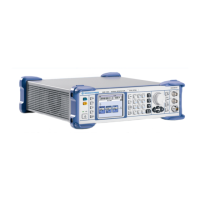R&S SMB Instrument Design and Function Description
1407.0806.82 3.3 E-6
RF Synthesizer/ DDS module
T
he 200 MHz signal of the TCXO provides the system clock for the DDS module. The RF output
frequencies from 9 kHz to 23.4375 MHz are generated directly by the DDS. In this mode all the
modulation is done fully digital. The modulated signal is converted to the analog domain by a DAC. The
analog RF signal is then low pass filtered, amplified and fed to the input of the step attenuator.
For set frequencies above 23.4375 MHz the DDS generates a signal with high resolution, that is
upconverted with the 200 MHz Signal from the TCXO and then applied as reference signal to the main
PLL of the RF frequency synthesizer. In the synthesizer a VCO is locked to the reference frequency using
a fractional-n-PLL. The VCO output signal is then fed to fixed frequency dividers which are set to
appropriate divider ratios to generate the RF signal from 23.4375 MHz to 2.2 GHz.
Harmonics filters
The output signal of the frequency dividers is a square wave signal. To reach the guaranteed harmonic
performance (see datasheet) the harmonics of the RF signal have to be suppressed. Due to the wide RF
frequency range multiple filters are needed. The different filters are selected according to the RF output
frequency and their cut off frequency. They are put into the RF signal path by the means of RF switches.
LF generator
The above mentioned DDS module also generates the LF sine wave or square wave signal. This signal
can be used as a source for internal modulation or as output signal at LFOUT BNC connector for
frequencies up to 1 MHz in sine wave mode or up to 20 kHz in square wave mode. The output amplitude
of the LF signal is set with a multiplying DAC in the range from 1 mV to 3 V.
Pulse Generator and Pulse Modulator
The pulse generator is also digitally implemented in the DDS module (FPGA). The pulse generator has
three different modes. The pulse generator can run free, can be triggered or gated externally using the
PULSE EXT input. The input impedance at the PULSE EXT BNC connector can be chosen
high-impedance or 50 K. The pulse signal serves as a source for internal pulse modulation and can
additionally be applied at the output PULSE/VIDEO in a buffered way.
Below 23.4375 MHz the pulse modulator is implemented digitally switching on and of the output signal of
the DAC. Above 23.4375 MHz three RF switches in series are used as pulse modulator.
Modulation matrix and AM/FM/.M modulator
The external modulation signal from MODEXT can be AC- or DC-coupled. This signal is converted into
the digital domain by the means of a 12 Bit ADC. The Frequency and Phase Modulations are
implemented fully digital in the DDS module..For output frequencies below 23.4375 MHz the AM is
implemented fully digital as well. For RF frequencies above 23.4375 MHz, the modulation signal is
applied as reference signal to the level control loop. The AM modulation depth is set by a multiplying
DAC. A switch matrix to select internal, external or internal + external modulation signals is implemented
in analog circuitry and additionally in the digital domain. For RF frequencies from 23.4375 MHz to
375 MHz a variable gain differential amplifier and above 375 MHz a PIN modulator is used as AM
modulator in the RF path.

